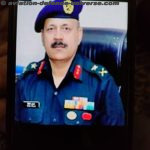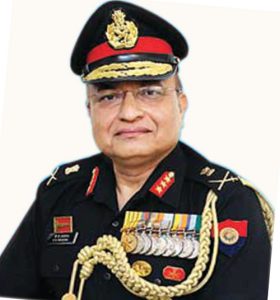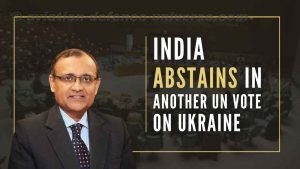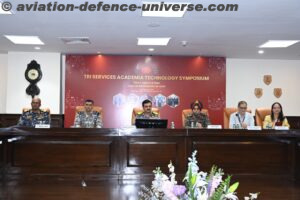
By Maj Gen Ashok Kumar, VSM (Retired)
New Delhi. 07 August 2022. Russia- Ukraine war having commenced on 24 Feb 2022 is still continuing and inching towards six months with no end in sight. Right from the start at the operation wherein it appeared that Russia will capture Ukraine in a very short time and Ukraine does not have a national will as well as the military capacity to fight with superior Russian forces but with progress of time, the table has been almost turned. Whether it is credited to Zelensky’s leadership of leading from the front, commitment of the defence forces for defending their motherland, all out support of USA and other NATO countries or inability of Russians to impose their national will due to lack of usage of potent defence equipment or a confused national strategy, will be more clear as and when this war comes to close and underlying factors of each stake holders are critically analysed. Majority of political, strategic, defense and economic analysts are still trying to dwell on the real aim of Russia in this conflict besides gauging if there is a pre-decided end state? It will be also important to know in the due course of time whether the ‘end state’ of this conflict has been fixed or has been modified based on the progress of the conflict or lack of it
The geographical area of Ukraine is not new to the conflict. Even during the WW 2 in 1941, in the first battle of Kiev, majority area went from USSR control to Germans and was back with USSR in 1943 through the second battle of Kiev. The area witnessed conflict post its independence with Russia in 2014 wherein it not only lost Crimea to Russia but pro- Russian forces also started exercising reasonable control in its Eastern region of Donbas. This also resulted in Minsk agreement getting signed in 2015 resulting in establishing of Line of Contact (LOC). Since the areas of Donbas had two states of Luhansk and Donetsk part of Donbas region who (though not recognized by any country prior to Russia-Ukraine war and Russia recognizing them as independent states only on 21 Feb 22, three days prior to launch of operation in Ukraine) had declared their independence in 2014 itself.
After Russian recognition, Syria recognized these states on 29 Jun 2022 followed by North Korea on 13 Jul 2022. Through the support has been extended by some other countries in form of supportive statement but the recognition by Russia followed by mutual defence treaty passed the legal way for Russia to intervene in Ukraine. Of course, it had its won justifications to invade Ukraine based on its security concerns wherein Ukraine was been to join NATO security umbrella and NATO was rapidly spreading Eastwards. Ukraine joining NATO would have meant Russia and NATO sharing the direct border. Not only this, since NATO deploys its troops and nuclear assets in its member countries, this would have also happened in Ukraine as well thus affecting the bottom line of Russian security concerns. The Russians focussed more on regime change in Ukraine and were hopeful that the same will be quickly achieved. Once the same plan was stuck, efforts to capture Kiev was put off and more focus was given towards liberation of Eastern and Southern regions and their interconnectivity.
Russia’s apparently confused political aim & un-coordinated land offensive have also dictated the use of air power or meaningful absence of it with Ukraine Air Defence playing some role. The employment of air resources as well as Air Defence resources by both countries reflect under utilisation of potency of air resources, salient aspects of employment of air and air defence resources both by Russia and Ukraine will be covered in succeeding paragraphs.
Russia
Authentic details of conflict related inputs are not available as there is huge propaganda machinery active from both the sides. To that extent, the analysis will be limited to the accuracy of inputs available in the open domain. The conventional use of air power necessitated supression of Air Defence resources of the adversary to achieve air superiority to facilitate the ground offensive. Not only this, it is supposed to neutralize the war waging potential of the adversary to a level wherein it becomes very easy for the ground forces to conduct their operations without much of opposition. Not only this, close air support is also extended to ground troops so that they achieve their objectives timely as it results in minimum loss to the equipment as well as to the soldiers.
Despite having the second largest Air Force in the world after USA with close to 4000 aircrafts including close to 40 fighter squadrons, close to 30 attack squadrons and AEW&C resources, the air war was almost missing. Close to 300 modern aircraft were deployed near Ukrainian border alone still Russia did not archive the air superiority. It also could not suppress the Air Defence resources of the Ukraine defence forces which have been having devastating effects on Russian air power predominantly from its land-based Air Defence resources.
During both Gulf wars, extensive use of airpower was done by the USA. Use of airpower in the aforesaid manner combined with large No of missiles being used prior to launch of ground operations became a kind of universal norm more so when the aggressor could posess favourable air resources as against the weaker adversary. In this conflict, Ukraine had hardly any major air resources, they had just close to 100 aircraft and all from the Soviet origin. Logically, it would have become easier for Russian AF to carry out effective destruction as they were more aware about the equipment features but even these things did not happen. While it can be understood that the Russians have been cautious in their war effort to avoid the civilian casualties and the civil infrastructure as they are aware that the country will need to be governed as well after the war is over. This notwithstanding the reasons behind the use of airpower and air defence resources of Russia needs to be analysed which has been done as under.
Russia lacked in establishing the air superiority. Large quantum of airpower specially the modern fleet was not used comprehensively. Air war alongwith missiles did not precede the ground ops as needed thus negation of resistance of Ukrainian defence forces could not be done resulting in large scale Russian causalities. Suppression of air defence resources was not done leaving Ukrainian ground based AD resources hitting Russian aircrafts and helicopters. Russians did not even drop the IR flares when Stinger missiles were launched against its aerial assets. No missile warning system appeared to be working/used.
Large scale absence of air operations was seen not only in the beginning but throughout the conflict. It is strange given the losses suffered by Russians besides having an extended conflict whether it is part of some hidden strategy or lack of it, will also be clear in the aftermath of the conflict. It appeared that Russia was not serious about suppression of Ukrainian air def despite taking a toll on its air resources. It did not utilise its stealth ac, modern latest ac and did not invest in surveillance at all. Even use of its UAVs was negligible despite successful use of UAVs by Ukraine brought from Turkey (Byraktar TB-2).
It appears that Russia lacked suitably trained manpower to use high end weapons and aerial platforms. Though it employed the veteran pilots also but they were not adept to use the latest aerial platforms not having been exposed on them.There appeared to be lack of skill sets and lack of institutional culture which are critical for conduct of successful air operations.
Russia appears to have modified its initial plan of capturing Ukraine as now the current actions are indicating that having captured the sizeable portion of Southern and Eastern portion of Ukraine, it is attempting to consolidate these along with their geographical linkage. This area is more suited for air operations rather than deep penetration strikes in Western and Northern portion of Ukraine. Missile and aerial attacks have been, however, continued off and on in those areas as well even being substantially effective at times. Close air support in the Donbas region has also been effective. The fleet serviceability has also been low, just close to 70 percent. It appears that higher maintenance and spare support precluded to replenish the unserviceable aircraft. Though exact details are not known but sanctions having some impact in sourcing these can’t be ruled out.
In addition to the serviceability of aircraft, missile serviceability for those to be launched from these platforms also raise lot of suspicion on Russian air operations. Use of precision guided munitions have also not been much. It has been predominantly the use of unguided munitions and attack paths following the predictable and low attitude paths which use the anticipated and low altitude alignments. Absence of effective air operations from Ukraine and limited availability of ground based air defence resources have been Russia’s saviour though it has suffered substantial casualties of its aerial resources even then.
Ukrainian actions have been predominantly defensive except one off offensive actions of firing missiles in shallow depth areas of Russia close to the borders. High mobility artillery rocket systems (HIMARS) provided by USA now have been fired across the border or in the areas currently under Russian occupation. These have not been intercepted effectively by Russian Air Defence System. It is beside the point that there is no conclusive proof of deployment of S-400 category of missile defence system by Russia.
And the analysis can continue but what will remain obvious to the world that either Russia lacked genuine capability to use its air power or there were other reasons for it. It happened in India-China war of 1962 as well wherein India did not employ its air power despite substantial territorial losses and human casualties.
Ukraine
Earlier being part of USSR, the country got independence in 1992 post breakup of USSR in 1991. Its entire equipping is from Soviet –now Russian inventory. It has total of 225 aircrafts including a little over 100 in attack and fighter category. Despite this, the Nos and variety makes it seventh largest AF of Europe and 27th largest in the world. Since the country had mothballed its equipment, serviceability and availability was adversely affected.
Since Ukraine was facing a relatively stronger adversary which was also having the largest No of nuclear war heads in the world, it did not have any plans to launch counter strikes either on the ground or in the air. It fought only as part of defensive strategy and continues the same till date except few offensive actions at local level or some shallow rocket strikes across the border.
A larger No of Ukrainian air resources were lost on ground whereas some were also lost in the air to air combat missions. It claims to have destroyed a large No of Russian aircraft but the losses claimed appear to be exaggerated. No authentic inputs on the same exists.
Ground based AD of Ukraine had credible performance. It has a wide range of AD systems to include 2K18 Kub, 9K37 M1 Buk, 9K 330Tar, S125 Nava/ Pechora and S-300. It also got TB-2 Byraktar UAVs from Turkey which was also used effectively. Once it got shoulder fired Stinger missiles, it used them very effectively. These shoulder fired missile systems were the primary cause of turning table against Russia in Afghanistan once utilised by opposing forces and provided by USA. HIMARS have also shown remarkable success. With progress of time, once Ukraine gets more such weapons, it may succeed in limiting its losses to some extent.
End View
There are important lessons to be learnt for India based on this conflict as for as use of air power and AD resources are concerned. India’s national philosophy has been use of soft power. While this is a good policy for the people of the world, there can be no soft power without hard power. It is therefore essential that a fresh re-appraisal of our equipment system in AF and AD is carried out and our acquisitions/ indigenous production/ upgrades be done factoring the lessons of this war as well as challenges being faced from the China and Pakistan including their collusivity. Availability of replenishing of spares including those of missiles/ armaments should be also a key factor for continuing a type of equipment in our inventory.
(Maj Gen Ashok Kumar, VSM (Retd) is a Kargil war veteran and defence analyst. He is visiting fellow of CLAWS and specialises on neighbouring countries with special focus on China. The views in the article are solely the author’s. He can be contacted at editor.adu@gmail.com).




























































































































